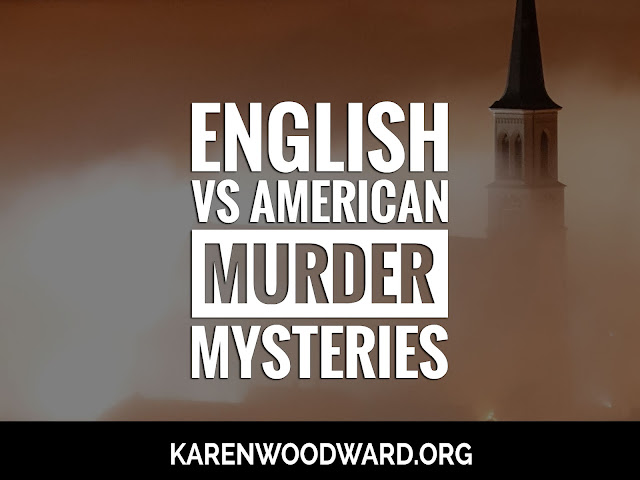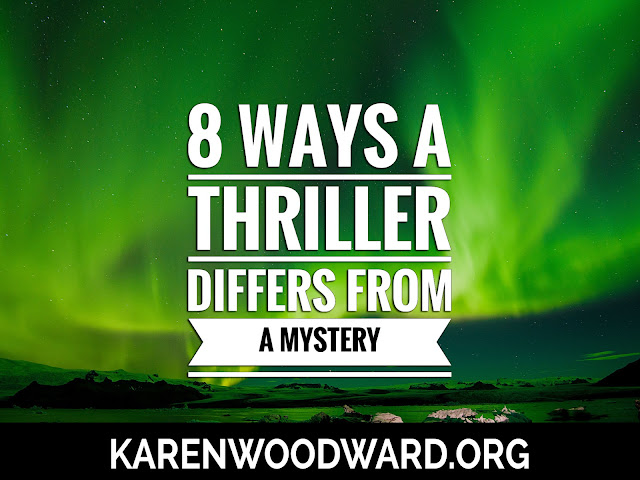Sorry this post is late! I’ve been working on my next book. This post is sort-of, kind-of a rough draft of a chapter for that book. So—as always!—your feedback is most welcome. :-)
I’ve been mulling over the question of what distinguishes an English murder mystery from an American one.[3] So, while I have a few ideas of my own (I’ve been a voracious reader of murder mysteries since the 9th grade), I did research.[5]
I LOVE Margaret Atwood’s writing, it’s so fluid, so alive. So I’ll let her take center stage and sum up some of the differences between an English and an American murder mystery:
“Their [American] world was fast-paced, sharp-edged, and filled with zippy dialogue and words I'd never heard pronounced—slang words like "gunsel", fancy words like "punctilious." This was not the Agatha Christie sort of story—there were fewer clues, and these were more likely to be lies people told rather than cuff buttons they'd left strewn around. There were more corpses, with less importance bestowed on each: a new character would appear, only to be gunned down by a fire-spitting revolver.”[4]Yes!!! I love Atwood’s writing, it has bite. You feel it, it’s rhythm.
Another person who has weighed in on the basic difference between English and American murder mysteries is W.H. Auden. In his wonderful essay “The Guilty Vicarage: Notes on the detective story, by an addict,”[2] Auden defined the whodunit as:
“The basic formula is this: a murder occurs; many are suspected; all but one suspect, who is the murderer, are eliminated; the murderer is arrested or dies.”I’ll come back to this in a moment. Right now let’s look at what, according to Auden, is the progress of the major events in a murder mystery:
Peaceful state before murder
Murder
False clues, secondary murder, etc.
Solution
Arrest of murderer
Peaceful state after arrest
Let’s Talk Character
And, while we’re at it, here (see below) is how Auden thinks of the progress of events that pertain to characters who are NOT the murderer. They may be guilty of something, but it’s not the murder under investigation.
False innocence
Revelation of presence of guilt
False location of guilt
Location of real guilt
Catharsis
True innocence
In addition, there is what Auden calls a “double reversal.” Have you ever read a murder mystery where you’re sure someone—call them Dan—committed the murder then something happens, the detective discovers some clue, one that makes it SEEM as though Dan couldn’t have done it? Then, at the end of the book, in the big reveal, it turns out Dan is the murderer? That’s a double reversal and, when done right, can be very satisfying for the reader.
I’ll come back to this progression later, perhaps in another post, but I wanted to include it here because I think it could provide someone with a valuable framework.
Now let’s continue our discussion of what an English murder mystery is and what it isn’t.
What an English Murder Mystery Is Not
As Auden points out, his definition excludes the following kinds of stories:
A. Readers Know Who the Murderer Is
In some murder mysteries readers know the identity of the murderer from the outset. For example, one of my all-time favorite murder mystery TV shows was Columbo. (It seems the writers of Columbo called it a “howcatchem” rather than a “whodunit” or “howdunit.”)
Not that no English mystery can be a howcatchem, but I believe it would be odd for a certain kind of English murder mystery—the cozy—to be a howcatchem, and I'm focusing on cozies. I’ll also, in a later post, discuss what I see as a subgenre of the murder mystery, the locked room mystery.
B. The Identity of the Murderer Isn’t the Focus of the Story
This point often applies to thrillers and caper stories. Recall that in a thriller the identity of the murderer often isn’t the focus of the story. Yes, there is an investigation, yes the detective gathers clues and decodes them, but catching rather than unmasking the killer is the ultimate goal.
In a caper story the question is: Will the group of theives be able to do it? Will they be able to pull off the perfect crime? That’s not to suggest that an element of mystery isn’t involved. For instance, there’s often a mole, a double-agent, in the group. The identity of this person is a mystery, but one that is usually solved before the climax.
How an English Murder Mystery Differs From Other Kinds of Mysteries
The Essential Function of the Detective
English Murder Mystery
Auden influenced my thinking about this. He held that the essential function of the detective was to restore justice—restore balance—to a community after the peace, the norms of the community, was violated. This is one reason many cozy mysteries take place in small close knit communities: a monastery, a rectory or the country estate of landed gentry.
The ultimate purpose of the sleuth was to mend the community's structure of social and moral values.
P.D. James, in her book Talking About Detective Fiction, argues that:
"The differences between the hard-boiled school and such Golden Age writers as Agatha Christie, Dorothy L. Sayers and Michael Innes, are so profound that it seems stretching a definition to describe both groups under the same category. If the British detective story is concerned with bringing order out of disorder, a genre of reconciliation and social healing, restoring the mythical village of Mayhem Parva to prelapsarian tranquillity, in the United States Hammett and Chandler were depicting and exploring the great social upheavals of the 1920s—lawlessness, prohibition, corruption, the power and violence of notorious gangsters who were close to becoming folk heroes, the cycle of boom and depression—and creating detectives who were inured to this world and could confront it on their own terms."
American Murder Mystery
American murder mysteries tend to be darker, much darker. The detective has given up on bringing balance to society. Given this, why does the detective bother to do what he does? Is it all about the money?
Not at all. In the American murder mysteries (though the motivation does vary) the detective solves the mystery and brings the murderer to justice (because either of his own personal internal will of ethics or because he has formed an emotional attachment to a person involved in the case. In short, the case has become personal for him. Just as no one needs anything as high sounding as a code of ethics to defend a loved one, so these detectives may have no code. They may, in fact, be what most of those in society think of as bad guys. But, still, they protect their own.
The Significance of Society
English Murder Mystery
Auden writes, “Murder is unique in that it abolishes the party it injures, so that society has to take the place of the victim and on his behalf demand restitution or grant forgiveness; it is the one crime in which society has a direct interest.”[2]
As P.D. James says, the location of a typical British mystery is much like the world she was born into. She writes:
As I was born in 1920 it was an England I knew, a cohesive world... It was an ordered society in which virtue was regarded as normal, crime an aberration, and in which there was small sympathy for the criminal; it was generally accepted that murderers, when convicted, would hang...”Accordingly, cozies (also known as ‘Country House mysteries’) were generally set in small interwoven communities and typically took the many interrelationships of such a community as a key theme.
American Murder Mystery
The American murder mystery is much darker. There is no sense of the detective striving to bring balance—justice and fairness—back to the community. In fact, sometimes the detective labors knowing that either this WON’T happen or that it will make the society MORE chaotic.
Closed versus Open Society
English Murder Mystery
In the English murder mysteries all the suspects come from a—to use Auden’s phrase—closed society.
This means that, in an English murder mystery, right from the get go we know who could have, and who could not have, committed the murder. In an American mystery we have our suspicions—perhaps we know certain characters are involved—but we don’t have the certain knowledge that one of a list of characters is the murderer.
This is one of the conventions of a cozy mystery. I would go so far to say if this isn’t the case, if the reader doesn't know who could have committed the crime, then the story in question cannot be a cozy mystery.
American Murder Mystery
In an American Murder Mystery the society usually isn’t closed although the reader does often feel the culprit is either one of the named characters OR one of the named characters is involved with the crime, although not the killer and one feels perhaps they were coerced. In this sense, the American murder mystery is a bit like the thriller.
The Detective and the Police
American Mysteries
It’s also telling, I think, that in American Mysteries the detective is often a loner, a private investigator who does not enjoy good relationships with most of the people on the police force. Perhaps one of them is kinda-sorta his friend, but even that is tenuous. Most police would just as soon lock him up and throw away the key.
And that’s another thing. American detectives, especially of Noir fiction, are usually male.
Perhaps this has changed in the last couple of decades, what with Eve Dallas (a fictional detective created by J.D. Robb, pen name of prolific writer Nora Roberts), Kinsey Millhone (a fictional character created by Sue Grafton for her alphabet murder mysteries) and last but surely not least Dr. Kay Scarpetta (a fictional medical examiner created by Patricia Cornwell).
English Mysteries
There isn’t as much to say about the relationship between the British detective and the police. Probably because the relationship is generally placid! And why wouldn’t it be? The detective is well heeled, knowledgeable, affable (if a little quirky) and generally quite happy to let the police take credit for solving the crime!
One of Agatha Christie’s less famous sleuths, Miss Marple, often had a more antagonistic relationship with the police, at least at first. They saw her as a meddlesome little old lady who couldn’t do anything for the investigation other than muck it up. As Miss Marple helped them prise apart the many delicate threads of the case, their attitude changed.
But, at least in Miss Marple’s case, the police were always fair in the sense they gave Miss Marple a fair shake. When she proved herself they, sometimes grudgingly, accepted her help and, often, thanked her at the end. This is perhaps the most significant difference between English mysteries and their American counterparts: in the hardboiled variety the world isn’t fair and this is reflected in the detective’s relationship with the police.
Often the local police despised the detective and even if the police believed he could help them solve the crime the police would have rejected his help. In fact, sometimes the police are corrupt and do not wish the crime solved!
The Private Life of the Detective
American Mysteries
Another difference between British and American mysteries is that in American mysteries—and in contemporary stories generally—the private life and loves of the detective are an important part of the story.
English Murder Mystery
I’m not saying that this disregard of the private life of the detective is true for ALL cozy’s, though I have found it to be true for most.
That said, in many contemporary cozy’s, those where the protagonist often owns her own business (a bakery perhaps) and has an on-again off-again relationship with the unbelievably gorgeous deputy, that this relationship isn’t an important B story. But it’s not the visceral, gut wrenching, demon-exploring scrutiny that can occur in the more American variants of the murder mystery.
The Temperament of the Detective
English Murder Mystery
And this brings us to what might be the single most important difference between American murder mysteries and English cozies: cozies are light and bright. As a general rule, nothing irredeemably bad happens to anyone in them except for the murder victim(s). Even then, the victims are often horrible people the townspeople had oodles of reasons to want dead.
Cozies are read as a diversion, as an escape, as a mental exercise.
That said, there are notable exceptions to this. I’m reminded of P.D. James’ wonderful character Adam Dalgliesh. He is tortured. Truly bad things happened to him and James’ other characters. And James wrote books that were classic English cozies.
To sum up, I think the generalization that British sleuths are emotionally muted in the sense that they are rarely frightened, that they are rarely themselves victims of crime, that they outwit the criminal rather than the reverse and that, taken collectively, they are a rather courageous lot, is more or less accurate.
American Murder Mystery
As Margaret Atwood mentioned, American detectives are at home on the mean streets, perhaps because they are more violent and know how to punch and jab and kick. Myself, I can’t imagine either Hercule Poirot or Miss Marple doing anything like that!
Commonalities Between English and American Mysteries
What is common between the genres? Both rely on suspense to drive the story forward.
Categories of Crime Fiction
The way I’ve been using the word, a whodunit is any crime story where a crucial element of the suspense, the mystery, is who committed the crime. In this sense, all of the following categories are whodunits.
The Categories:
Cozy mystery
Locked room mystery
Historical murder mystery
Hardboiled murder mystery
Police procedural murder mystery
Forensic murder mystery
Legal thriller
Every post I pick something I love and recommend it. This serves two purposes. I want to share what I’ve loved with you, and, if you click the link and buy anything over at Amazon within the next 24 hours, Amazon puts a few cents in my tip jar at no cost to you. So, if you click the link, thank you! If not, that’s okay too. I’m thrilled and honored you’ve visited my blog and read my post.
Who doesn’t like a good Choose Your Own Adventure book? Get six of R.A. Montgomery’s Choose Your Own Adventure novels in this Box Set: Race Forever, Escape, Lost on the Amazon, Prisoner of the Ant People, Trouble on Planet Earth, War with the Evil Power Master.
From a K. Grissom’s review: “We bought these books for our son because we remembered how much we loved them at his age. They are much quicker reads than I remember, but he loves them, so they get 5 stars. One book takes him less than 45 minutes to get through.”
That’s it for now! I’ll have another post for you tomorrow and to catch up, another one either Saturday or Sunday. Until I talk to you again, good writing!
Notes:
1. The Roots of American & British Crime Fiction, by Seonaidh Ceannéidigh.
2. “The Guilty Vicarage: Notes on the detective story, by an addict,” By W.H. (Wystan Hugh) Auden.
3. Here I talk about British and American mysteries but could just as easily have talked about softboiled versus hardboiled mysteries.
4. “Mystery writer,” by Margaret Atwood.
5. A note on terminology. The way I’m using the words, “whodunit” is ambiguous between English and American murder mysteries. To my mind the essential characteristic of a whodunit is just what the name suggests: The focus of the story—the story question—has to do with who committed the murder. As opposed to, say, how the murderer committed the crime or whether and how the murderer was caught.












